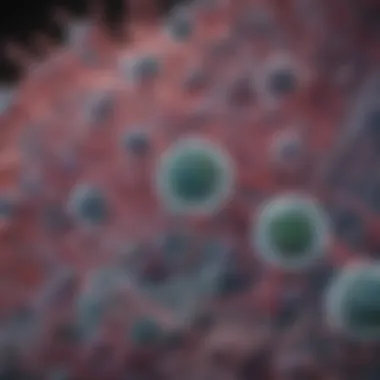Exploring the Role of Anti-Active Caspase 3 Antibody


Intro
The anti-active caspase 3 antibody has emerged as a pivotal reagent in cell research, especially concerning the study of apoptosis, or programmed cell death. Understanding apoptosis is crucial for various scientific fields, including cancer research, developmental biology, and neurobiology.
This article aims to provide a thorough examination of the role of this antibody in research settings. By highlighting its significance, providing insights into its function, and exploring applicable methodologies, we create a foundational resource for students, researchers, and professionals.
Research Overview
Summary of Key Findings
The anti-active caspase 3 antibody primarily facilitates the identification and quantification of active caspase 3, a key enzyme in the apoptosis cascade. Its ability to detect the presence of this active form in cells allows researchers to analyze cell death pathways and their implications in disease processes. Findings across various studies have demonstrated that the modulation of caspase activity influences cellular outcomes in numerous contexts.
The importance of accurately detecting active caspase 3 cannot be overstated, as it serves as a reliable indicator of the apoptotic process within cells.
Relevance to Current Scientific Discussions
This antibody is often discussed in relation to cancer research and neurodegenerative diseases, where apoptosis modulation plays a critical role. In cancer, the ability to evade apoptosis can lead to tumor survival and growth, complicating treatment strategies. Conversely, excessive apoptosis is often observed in neurodegenerative disorders such as Alzheimer's disease. Thus, the anti-active caspase 3 antibody is integral to ongoing research efforts aimed at unraveling these complex mechanisms.
Methodology
Research Design and Approach
Research involving the anti-active caspase 3 antibody typically employs various experimental designs, often integrating in vitro and in vivo models to elucidate the role of apoptosis in different cellular contexts. Common approaches include the use of cell lines, primary cells, and animal models, depending on the research question at hand.
Data Collection and Analysis Techniques
Data collection methods often encompass Western blotting, immunofluorescence, and flow cytometry. These techniques allow for the quantification of active caspase 3 in cells under various experimental conditions. Following data collection, statistical analysis is critical for validating findings and ensuring reproducibility of results. Techniques such as ANOVA or t-tests may be applied to interpret the significance of data accurately.
Overall, understanding how to utilize the anti-active caspase 3 antibody effectively can significantly impact research outcomes in the field of cellular biology.
By continuing to develop methodologies and enhance the integration of this antibody into research practices, scientists can deepen their understanding of apoptosis and its far-reaching implications in health and disease.
Preface to Caspases
Caspases play a vital role in the process of programmed cell death, known as apoptosis. Understanding caspases is critical in cellular research. They are not just enzymes; they act as essential regulators of cell survival and death. This section aims to establish the fundamental knowledge regarding caspases, setting a foundation for the exploration of the anti-active caspase 3 antibody.
Overview of Caspases
Caspases, short for cysteine-aspartic proteases, are a family of proteins that execute apoptosis. They exist as inactive precursors called procaspases and become activated in specific cellular contexts. This activation process involves proteolytic cleavage, which transforms these precursors into active caspases.
Caspases are classified into two main groups: initiator and effector caspases. Initiator caspases, like caspase 8 and 9, respond to apoptotic signals and activate the effector caspases, such as caspase 3, 6, and 7. The activation of effector caspases culminates in cellular demolition, leading to the characteristic features associated with apoptosis. Recognizing the different caspase types and their functions is essential for any research related to cell death and survival.
Role of Caspases in Apoptosis
Caspases are central to the apoptotic process. They facilitate the cleaving of vital intracellular substrates. This action leads to morphological changes in the cell, such as cell shrinkage, membrane blebbing, and chromatin condensation.
The role of caspases does not stop at executing apoptosis. They also participate in regulating inflammation and cell differentiation. This multifaceted functionality suggests that caspases are positioned at the crossroads of various cellular processes. In apoptosis, the modulation of caspase activity somehow determines the cell's fate, highlighting their importance in both healthy and pathological states. Therefore, studying caspases and their in-depth mechanisms is not just illuminating for fundamental biology but also pivotal for developing therapeutic strategies in diseases where apoptosis is dysregulated.
Understanding Active Caspase


Active caspase 3 holds a pivotal place in cell biology, particularly within the framework of programmed cell death or apoptosis. This enzyme is known as an executioner caspase due to its role in the final stages of apoptosis, where it orchestrates cellular dismantling. Grasping the functions and mechanisms of active caspase 3 is crucial for scientists engaged in apoptosis research, cancer studies, and neurodegenerative disorder investigations.
The significance of studying active caspase 3 lies in its implications for understanding cellular health and disease. For instance, in cancer, the dysregulation of apoptosis can lead to unchecked cell proliferation. Similarly, in neurodegenerative diseases, the inappropriate activation of apoptosis can contribute to neuronal loss. Therefore, elucidating the function and activation of active caspase 3 can provide insights that may lead to therapeutic breakthroughs.
Function of Active Caspase
Active caspase 3's main function is to cleave various cellular substrates. This action results in the breakdown of key structural and functional proteins, thereby facilitating cell death. Some of these targets include:
- Poly(ADP-ribose) polymerase (PARP): An important figure in DNA repair, caspase 3's cleavage of PARP inhibits its repair function, pushing the cell toward apoptosis.
- Cytoskeletal proteins: By targeting proteins such as actin and lamin, active caspase 3 contributes to cellular reorganization and fragmentation, marking the final farewell of a dying cell.
- Regulatory proteins: This includes proteins that control apoptosis processes, leading to enhanced apoptotic signaling.
Such functions illustrate why understanding active caspase 3 is essential for comprehending not just the apoptosis pathway, but also broader cellular dynamics in health and disease.
Mechanisms of Activation
The activation of caspase 3 is a finely tuned process essential for its role in apoptosis. It generally occurs via two primary pathways: the extrinsic and intrinsic pathways. Each pathway has specific trigger points that converge towards the activation of pro-caspase 3.
- Extrinsic Pathway: Triggered by extracellular signals, this pathway is initiated when death ligands such as FasL or TNF-alpha bind to their respective receptors on the cell surface, leading to the formation of the death-inducing signaling complex (DISC). This complex subsequently activates initiator caspases like caspase 8, which in turn cleave pro-caspase 3 into its active form.
- Intrinsic Pathway: This pathway responds to internal cellular stressors, such as DNA damage or oxidative stress. It primarily involves the release of cytochrome c from mitochondria. Cytochrome c binds to Apaf-1, forming the apoptosome, which activates caspase 9. Activated caspase 9 then activates caspase 3, sustaining the apoptotic cascade.
Both pathways demonstrate how tightly regulated these processes are, ensuring that active caspase 3 is only produced when the cell is irreparably damaged or no longer needed. Thus, understanding these mechanisms is vital for developing interventions in diseases where apoptosis is dysregulated.
What is an Anti-Active Caspase Antibody?
Understanding the role and function of anti-active caspase 3 antibodies is crucial for researchers involved in cellular biology, especially those focusing on apoptosis. These antibodies provide valuable insights into the mechanisms of cellular death, determining the activation state of caspase 3—a key player in the apoptotic process. This section explores the underlying definitions, purposes, and types of these important reagents, outlining their significance in experimental settings.
Definition and Purpose
An anti-active caspase 3 antibody specifically recognizes and binds to the active form of caspase 3. This enzyme is recognized for its role in the execution phase of apoptosis. The detection of active caspase 3 allows researchers to assess cellular responses to various stimuli that may induce apoptosis. By understanding when and how caspase 3 becomes activated, scientists can elucidate pathways that lead to cell death or survival.
The purpose of using an anti-active caspase 3 antibody extends beyond simple detection. It can serve various functions, including:
- Confirming Apoptosis: By identifying active caspase 3, researchers can confirm that cells are undergoing programmed death in response to specific signals.
- Investigating Inhibitors: Scientists can assess the efficacy of potential caspase inhibitors, contributing to the development of therapeutic strategies, especially in cancer where apoptosis evasion is common.
- Understanding Disease Mechanisms: In neurodegenerative diseases, increased caspase activity is often observed. Using these antibodies allows for the investigation of disease progression and potential interventions.
Types of Anti-Active Caspase Antibodies
Several types of anti-active caspase 3 antibodies are available, influenced by various factors such as specificity, source, and applications. The main categories include:
- Monoclonal Antibodies: These antibodies are derived from a single clone of immune cells. They offer high specificity and sensitivity, making them suitable for various applications including flow cytometry and immunofluorescence. They are often preferred for quantitative analysis.
- Polyclonal Antibodies: Generated from multiple immune cell lines, these antibodies recognize a broader range of active caspase 3. While they can be useful in general studies, they may exhibit batch-to-batch variability. They are often more cost-effective compared to monoclonal antibodies.
Both types come with their considerations. Monoclonal antibodies may require more rigorous validation to ensure consistency across experiments. In contrast, polyclonal antibodies might offer broader detection but come witt potential cross-reactivity.
"Selecting the appropriate type of anti-active caspase 3 antibody is crucial for achieving reliable results in experimental procedures."
In summary, anti-active caspase 3 antibodies stand as pivotal tools in cell biology research. Their ability to illuminate the activation of one of the most significant caspases allows researchers to explore intricate cellular processes in both health and disease.
Applications in Research
The exploration of anti-active caspase 3 antibodies in cellular research holds significant importance, particularly in understanding apoptosis. These antibodies serve as a gateway to unraveling the complexities of programmed cell death and signaling pathways. Their application extends beyond just theoretical implications; they are crucial in practical, experimental contexts where precise detection and quantification of apoptosis are necessary.
One of the key elements is their reliability in providing insights into cellular health. Researchers utilize these antibodies to distinguish between healthy and apoptotic cells, enabling a clearer understanding of biological processes. This distinction is essential for many applications, especially in the fields of cancer research, neurobiology, and developmental biology.
Used in Apoptosis Studies


The anti-active caspase 3 antibody is instrumental in apoptosis studies. This process involves a series of complex molecular events leading to cell death, an essential mechanism in both normal development and disease systems. By using this antibody, researchers can detect the presence of active caspase 3, which acts as a marker for cells undergoing apoptosis.
The method typically involves
- Immunohistochemistry, which allows for visual assessment of tissue sections.
- Flow cytometry, providing quantitative data on cell populations.
- Western blotting, enabling precise identification of protein levels.
These methodologies enhance the reliability of findings. With robust detection methods, the interpretation of cellular events becomes clearer, allowing for effective experimentation in studying the dynamic nature of apoptosis.
Potential in Cancer Research
Cancer research benefits immensely from the use of anti-active caspase 3 antibodies. These antibodies allow scientists to assess how cancer cells respond to various treatments and how they evade apoptosis. Understanding these mechanisms is crucial in developing therapies aimed at inducing apoptosis in cancer cells.
In clinical studies, measuring active caspase 3 levels can help determine the effectiveness of chemotherapy. When cells respond positively to treatment, an increase in active caspase 3 indicates apoptosis is occurring. This gives oncologists a tool to evaluate treatment plans and make informed decisions based on empirical data.
Role in Neurodegenerative Disorders
In neurodegenerative disorders, the application of anti-active caspase 3 antibodies has opened new avenues for research. Diseases like Alzheimer’s and Parkinson’s show a unique relationship with apoptosis, where excessive or insufficient programmed cell death can have significant consequences.
By investigating apoptosis through these antibodies, researchers gain insights into the pathophysiology of such disorders. For example, the study of active caspase 3 levels can reveal whether neuronal loss is due to increased apoptosis or not. This can further lead to hypotheses on how to better target therapies aimed at regulating cell death pathways in these conditions.
"The ability to precisely measure apoptosis provides critical insights in both cancer biology and neurodegeneration."
In summary, the applications of anti-active caspase 3 antibodies in research extend far and wide. They are crucial tools in studying apoptosis, evaluating cancer treatments, and understanding neurodegenerative diseases. This positions them at the forefront of cellular and molecular biology, aiding in the advancement of targeted therapeutic strategies.
Significance of Detection Techniques
The detection techniques used in research involving the anti-active caspase 3 antibody are crucial for gaining accurate insights into cellular processes. These methodologies enable scientists to visualize and quantify the presence of active caspase 3 in various cellular contexts. The significance lies not only in the ability to confirm apoptosis, but also in the potential to understand the underlying mechanisms that lead to cell death. This is particularly important in areas such as cancer research and neurodegenerative diseases.
Methods for Detection
Immunohistochemistry
Immunohistochemistry is a widely adopted technique in cell research. It allows for the localization of active caspase 3 within tissue sections. The key characteristic of this method is its ability to preserve the cellular architecture, providing contextual information about the tissue. Researchers appreciate immunohistochemistry for its sensitivity and specificity when detecting proteins.
One unique feature of this technique is the use of specific antibodies tagged with a visible marker, which binds only to the target protein. This allows for effective visualization under a microscope. However, its disadvantages include variability in staining intensity and potential background interference, which can mislead the interpretation of results.
Western Blotting
Western blotting is another essential technique for confirming the presence of active caspase 3. This method involves separating proteins via gel electrophoresis and then transferring them to a membrane. The key characteristic of western blotting is its quantitative capability, allowing for assessment of protein expression levels. It is beneficial for determining the activation status of caspases, offering clear data that can lead to better insights into apoptosis mechanisms.
The unique feature of western blotting is the ability to detect multiple proteins simultaneously when using specific antibodies. Its main disadvantage, however, is that it requires more time and careful handling, as errors can occur during transfer and detection phases.
Flow Cytometry
Flow cytometry stands out for its speed and ability to analyze thousands of cells per second. This technique is crucial for identifying and quantifying active caspase 3 at the single-cell level. The key characteristic of flow cytometry is its capacity to provide simultaneously data on multiple parameters for each cell. This allows for a detailed analysis of cell populations in a sample, aiding in understanding the dynamics of apoptosis.
The unique feature of flow cytometry is its real-time analysis of live cells, enabling researchers to observe cellular events as they happen. Nonetheless, it may require expensive equipment and skilled personnel, which can be limitations for some laboratories.
Interpreting Results
Interpreting results from these detection techniques demands a thorough understanding of the applied methodologies. It is essential to critically analyze data in the context of experimental conditions. Factors such as antibody specificity, signal intensity, and the biological state of the cells must be considered to draw accurate conclusions about active caspase 3 levels.


The precision of the results from these techniques significantly affects the validity of findings in apoptosis research.
In summary, detection techniques are vital for advancing the understanding of the anti-active caspase 3 antibody's role in cellular processes. Understanding each method's strengths and limitations can guide researchers in making informed choices, ultimately leading to more robust and insightful conclusions.
Challenges in Using Anti-Active Caspase Antibodies
Working with anti-active caspase 3 antibodies presents several challenges that researchers must navigate effectively. These challenges are critical in ensuring accurate and reliable results in experiments related to apoptosis. Understanding the issues that may arise with these antibodies is essential for researchers aiming to produce meaningful scientific discoveries.
Specificity Issues
Specificity is one of the foremost concerns when using anti-active caspase 3 antibodies. These antibodies should ideally recognize only the active form of caspase 3. However, there is a risk of cross-reactivity, where the antibody may bind to other proteins that share similar epitopes. Such cross-reactivity can lead to false positives in experimental results, complicating the interpretation of data. Moreover, different antibody batches may exhibit variations in specificity, further complicating reproducibility.
To mitigate such specificity issues, it is advisable to validate the antibodies through rigorous testing. This can involve comparing results with other established methods or using knockout models to confirm the antibody's specificity. Keeping updated with the latest research on specific antibody performance can also enhance the reliability of results.
Reproducibility of Results
Reproducibility is a critical aspect of any scientific investigation, especially in the context of apoptotic research. Results obtained from experiments using anti-active caspase 3 antibodies may suffer from variability due to several factors. This can include differences in sample preparation, antibody dilution factors, or even batch-to-batch variability of the antibody itself.
A lack of reproducibility can seriously undermine the scientific validity of findings. Therefore, it is essential for researchers to standardize their protocols wherever possible. This includes using consistent biological samples and maintaining strict protocols for antibody usage. Also, documenting each step of the experiment can help others replicate the study accurately and avoid the pitfalls of variability.
Advancements in Antibody Development
The field of antibody development has witnessed significant growth in recent years. This evolution is crucial for improving research outcomes, enhancing specificity, and increasing utilization in various scientific fields, especially in cell research. With the increasing complexities of biological systems, advancements have made it possible to tailor antibodies to address specific research needs.
Technological Innovations
One of the primary drivers behind progress in anti-active caspase 3 antibody development is the advent of sophisticated technologies. Given the intricate structure of proteins and their interactions, innovations have led to a more refined approach in antibody design. Some key advancements include:
- ** recombinant DNA technology**: This technique allows for the mass production of specific antibodies which ensures consistency and high purity.
- Monoclonal antibody technology: Helps generate antibodies that are identical and target specific antigens.
- Nanotechnology: Enhancements in formats, such as nano-sized antibodies, offer greater accessibility and functional capabilities in experiments.
The amalgamation of these technologies not only accelerates the road to successful applications but also ensures the antibodies generated are high-quality and effective.
Future Directions in Research
Future directions in the development of anti-active caspase 3 antibodies hold promising potentials. As research becomes more intricate, the role of these antibodies expands into new territories. Several paths forward include:
- Personalized Medicine: Antibodies that are tailored to individual profiles offer hope in cancer treatments, where their specific applications could maximize therapeutic effects.
- Application in Diagnostics: Advanced antibodies can serve as key tools in the earlier detection of diseases, enabling timely interventions.
- Expanding the Spectrum of Applications: Beyond apoptosis, anti-active caspase 3 antibodies could be explored further in other physiological pathways, making them valuable assets across various domains in biology.
> The growth in antibody technology particularly aids in translating basic research findings into clinical practices.
Overall, staying abreast of innovations and maintaining a forward-looking approach will significantly advance research outcomes. By continuously optimizing the tools available to researchers, the field will not only enhance research depth but also broaden the horizons of potential scientific breakthroughs.
The End
The conclusion serves as a pivotal component in summarizing the extensive discussion about the anti-active caspase 3 antibody and its role in cellular research. It allows a reader to understand the nuances of the findings while providing clarity on the implications derived from this information. Addressing various aspects from detection techniques to challenges faced in experimentations, a comprehensive conclusion ensures that all the points discussed are synthesized effectively. By emphasizing the significance of this antibody, not only in apoptosis research but also in other biological investigations, the conclusion reinforces the need for continued studies and discussions in this domain.
Summary of Key Points
- Anti-Active Caspase 3 Antibody Importance: This antibody is vital in detecting apoptosis, making its role critical for countless studies aimed at understanding cell death mechanisms.
- Research Applications: The applications span across multiple fields including cancer research, neurodegenerative disorders, and general cellular biology research.
- Detection Techniques: Various methodologies such as immunohistochemistry, Western blotting, and flow cytometry are integral to analyzing the effectiveness and specificity of this antibody.
- Challenges: Specificity and reproducibility issues are common when employing anti-active caspase 3 antibodies, underlining the intricacies involved in these studies.
Implications for Future Research
Future research must focus on addressing the existing challenges and advancing technologies relating to antibody specificity and reliability. Enhanced detection methods could provide more precise data, aiding in the understanding of apoptosis and associated diseases.
Moreover, as methodologies evolve, the scope of anti-active caspase 3 antibody applications may expand beyond current understandings, opening doors to novel therapeutic strategies. Research teams should also consider large-scale collaborations to share insights and resources, fostering truly innovative approaches to complex cellular processes.
The need for refined antibodies that address specificity issues can lead to breakthroughs in therapeutic development. Overall, the future seems promising, with the anti-active caspase 3 antibody at the forefront of critical research advancements.



